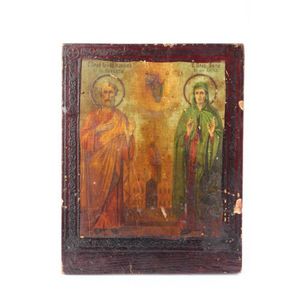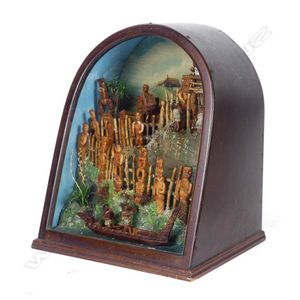Jane Brenkley's Maori Diorama - Folk Art Masterpiece
You must be a subscriber, and be logged in to view price and dealer details.
Subscribe Now to view actual auction price for this item
When you subscribe, you have the option of setting the currency in which to display prices to $Au, $US, $NZ or Stg.
- Diorama - When used in relation to antiques and collectables, a diorama is a three dimensional display, usually within a domed or rectangular glass case.
As the feathers of birds are more easily damaged than the skin of an animal, most taxidermied birds are displayed within a glazed diorama. The birds will be set in lifelike poses in a naturalistic landscape, usually standing a branch within the diorama. Animals will be displayed set in the landscape they inhabit. The foreground will be set with gravel, rocks and bushes, while the background will be painted.
While most natural history dioramas can be easily picked up and carried by one person, some larger examples were made that were suitable for display at exhibitions.
The other type of diorama commonly seen is a model ship enclosed in a rectangular glass box, the ship depicted floating on the sea. - Important - Important is a word used in the antique trade to indicate an object should be ranked above other similar objects, and is therefore more valuable.
The object could be considered important because it is by a famous designer or maker, has been shown at a major exhibition, is of exquisite workmanship, is rare or is a "one-off", was made for an important patron, and so on.
Even further up the pecking order are objects that are described in catalogue descriptions as highly important or extraordinarily important.
This item has been included into following indexes:
Visually similar items

Italian hand painted Studio ceramic tile signed lower left, measures 28.5 x 14.8 cm

Mother and child, gouache and gold on paper, 205 mm x 104 mm. Provenance: From the collection of Lockwood de Forest II (1850-1932) and by descent to its current owner

Antique 18th century French school portrait of a lady, oil on board, unsigned, approx 39 cm x 30 cm

19th century Russian icon, of rectangular form, painted with saint and Madonna, standing in front of church, with script, surrounded by finely carved border, with Christies label verso, 20.5 cm x 16 cm
